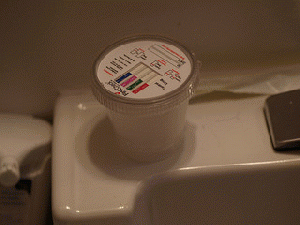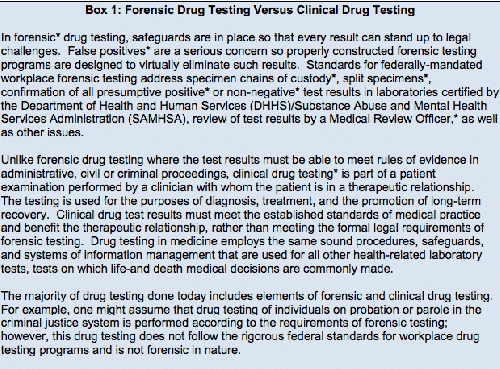Chain-of-Custody refers to the document or paper trail showing the collection, control, transfer, analysis and disposition of laboratory tests. It is the written documentation of a specimen from the moment of collection to the final destination to the review and reporting of the final results. The multi-part chain-of-custody form, or "custody and control" form, is part and parcel of this process. It contains stickers to sign and seal the specimen so that it cannot be tampered with and the form itself is signed by the appropriate parties as the test specimen travels from place to place. Information is added to the form as it travels from person to person. It has been given the status of a legal document as it has the ability to invalidate a specimen with incomplete information. Once the sample is analyzed it is reviewed by a Medical Review Officer (MRO) for final review. In the case of a positive test it is the responsibility of the MRO to ascertain an intact chain-of-custody, determine whether an alternative explanation exists for the positive test such as a prescribed medication, and then and only then report the test as a "true positive."
The MRO looks for what are called "fatal flaws" and, should one be present, invalidates the test. A fatal flaw requires the test be rejected as it were never drawn. It invalidates it and it cannot be used.
Forensic versus Clinical Drug Testing
Forensic drug testing is done for medico-legal purposes. It is used for testing people for substances of abuse or substances in those who should not be using them. Forensic drug testing results in consequences. These consequences can be grave and far-reaching if the drug-testing is being done by a regulatory agency or some other body given the power to sanction or punish. Loss of careers, of child-custody, and of rights and freedoms can all depend on results of a single test.
Random drug-testing done in the workplace is also forensic but the consequences are usually quite different. A positive drug-test done in this manner typically results in an assessment, treatment if indicated, and compliance with some sort of monitoring protocol in order to return to work.
Forensic drug testing follows more stringent guidelines than clinical testing because of these consequences. Some are more stringent than others, requiring split-specimen samples and the use of only certified labs. But the minimum requirements for any and all drug testing include strict chain-of-custody procedures and review by a certified MRO.
Clinical drug testing, on the other hand, occurs in the course of a doctor caring for a patient. It is done to diagnose and treat and cannot be used outside this purview. The results of a clinical test are part of the medical record and deemed 'Protected Health Information' (PHI). The results are protected by HIPPA and cannot be disclosed to anyone not directly involved in your direct medical care without your written consent. There are no additional guidelines in place for clinical drug-testing as patient autonomy is preserved. A positive result could result in a recommended course of action by the physician but it is still up to the patient whether or not to follow that recommendation. It is not imposed. But there are some groups who want to change that by blurring the lines between "forensic" and "clinical" drug testing.
The ASAM White Paper on Drug Testing
According to the ASAM White Paper on Drug Testing, clinical drug-testing "employs the same sound procedures, safeguard, and systems of information management that are used for all other health-related laboratory tests, tests on which life-and-death medical decisions are commonly made." In the box above they describe the multiple safeguards in place and requirements demanded of "forensic" drug testing, but do not mention the reason these uncompromising and multiple specifications exist is to protect the donor from a false accusation of drug or alcohol use. They proceed to define "clinical drug testing" as "part of a patient examination performed for the purposes of diagnosis, treatment, and the promotion of long-term recovery", noting that clinical testing "must meet the established standards of medical practice and benefit the therapeutic relationship, rather than meeting the formal legal requirements of forensic testing." The authors then state that the "majority of drug testing done today" includes both forensic and clinical elements, using individuals on parole and probation as examples.
The logical fallacy here is striking. It is comparing apples and oranges. After detailing the specific quality-assurance safeguards designed to prevent the donor of a drug or alcohol test from being falsely accused of illicit use, the authors give a general definition and purpose of "clinical" testing then state that when testing for drugs the systems in place are up to snuff as it is already being used to make life-and-death medical decisions. The take-home message is that "forensic" testing is unnecessary hyperbole designed for legal challenges. The clinical lab systems in place are used for critically important testing so it can be used for drug-testing. After all, parolees and probationers don't require it.
Forensic guidelines developed in collaboration with occupational and environmental medicine specialist, clinical and forensic toxicologists, pathologists and others, and each of these requirements exists to assure the validity and accuracy of the testing process and protect the donor. If "clinical" testing context had fit the bill then "forensic" testing would not have evolved. Labs ordered clinically in the course of patient care are interpreted within the context of multiple other pieces of data. Lab errors occur all the time and are interpreted in that context.
Oftentimes a lab will not fit with the clinical picture and, when that happens, a repeat lab is ordered for verification. Specimens get collected in the wrong tube and specimens get lost but in the clinical setting they simply get reordered and there are no consequences to patient care. In contrast drug testing is an all-or-none one-shot test and the results have consequences. It is for that reason they must be valid.
Chain-of-custody and MRO review are critical and that is why most drug-testing programs follow the forensic protocol. And the example of non-forensic drug-testing parolees and probationers is misleading. Any Employee Assistance Program that has a union or some other group looking out for their best interests uses strict "forensic" guidelines. Parolees and probationers have no power and have no choice. Besides, the National Association of Drug Court Professionals uses the Laboratory Developed Tests these same people introduced to test individuals on probation or parole in the criminal justice system just as they do in the PHPs.
(Note: You can view every article as one long page if you sign up as an Advocate Member, or higher).






